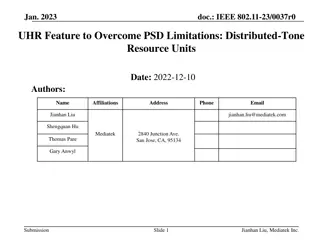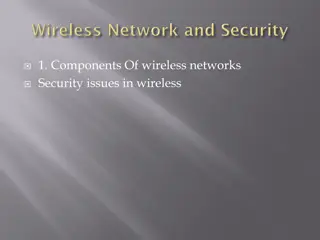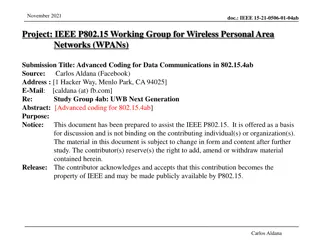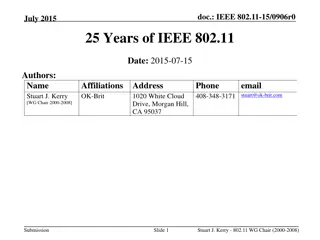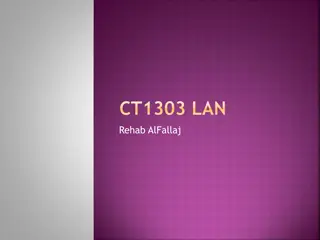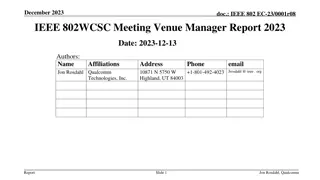Understanding IEEE 802.11b Wireless LANs
IEEE 802.11b wireless LAN standard shares similarities with Ethernet LANs but also has distinct differences due to its wireless nature. It operates in the industrial, scientific, and medical RF bands, supporting features like infrastructure mode, multiple channel access protocols, and DSSS signal spread. The protocol stack involves layers 1 and 2, with cells managed by access points using specific channels. This standard allows for mobile devices to connect and roam within a WLAN environment.
Download Presentation

Please find below an Image/Link to download the presentation.
The content on the website is provided AS IS for your information and personal use only. It may not be sold, licensed, or shared on other websites without obtaining consent from the author. Download presentation by click this link. If you encounter any issues during the download, it is possible that the publisher has removed the file from their server.
E N D
Presentation Transcript
WiFi Networks: IEEE 802.11b Wireless LANs Carey Williamson Department of Computer Science University of Calgary
Background (1 of 2) In many respects, the IEEE 802.11b wireless LAN (WLAN) standard is similar to that for classic IEEE 802.3 (Ethernet) LANs Similarities: LAN with limited geographic coverage multiple stations, with 48-bit MAC addresses shared transmission medium (broadcast technology) CSMA-based Medium Access Control protocol comparable data rates (11 Mbps vs 10 Mbps)
Background (2 of 2) But there are also many distinct differences: wireless (air interface) versus wired (coax) wireless propagation environment (multipath) higher error rate due to interference, etc. successful frames are ACKed by receiver mobile stations versus fixed stations half-duplex versus full-duplex operation hidden node and exposed node problems potential asymmetries of links CSMA/CA versus CSMA/CD multiple data transmission rates (1, 2, 5.5, 11)
Some WiFi Features Infrastructure mode vs ad hoc mode Access Point (AP) sends beacon frames Mobiles choose AP based on signal strength Multiple channel access protocols supported CSMA/CA (DCF); PCF; RTS/CTS MAC-layer can provide error control, retransmission, rate adaptation, etc. Direct Sequence Spread Spectrum (DSSS) signal spread across 14 22-MHz channels
Where Does Wireless RF Live? ISM (Industrial, Scientific, Medical) band 902-928 MHz 2400-2483.5 MHz 5725-5850 MHz Old Wireless 802.11a 802.11/802.11b,g Bluetooth Cordless Phones Home RF Baby Monitors Microwave Ovens
Protocol Stack View Application Telnet, FTP, Email, Web, etc. Presentation Session TCP, UDP Transport IP, ICMP, IPX Network Logical Link Control - 802.2 (Interface to the upper layer protocols) Data Link MAC Wireless lives at Layers 1 & 2 only! 802.3, 802.5, 802.11 Physical Layer Convergence Protocol Physical LAN: 10BaseT, 10Base2, 10BaseFL WLAN: FHSS, DSSS, IR
Wireless Cells Access Point coverage area is called a Cell Access Point Channel 6 ESSID: NAI 11 Mbps bandwidth shared by all devices in the Cell! Range per Access Point is 100m In Canada/US, there are eleven 802.11 channels Only channels 1, 6 and 11 are non-overlapping Computers can roam between cells
Multiple Wireless APs 1 1 6 11 11 1
Medium Access Control (MAC) Carrier Sense Multiple Access with Collision Avoidance How CSMA-CA works: Device wanting to transmit senses the medium (Air) If medium is busy - defers If medium is free for certain period (DIFS) - transmits Latency can increase if air is very busy! Device has hard time finding open air to send frame! * DIFS - Distributed Inter-Frame Space (approx 128 s)
MAC Protocol (Contd) others source dest Air is free for DIFS time period DIFS NAV: defer access data send frame All other devices must defer while air is busy SIFS Receive ACK that frame was received intact! ack Every frame is acked - except broadcast and multicast! * SIFS - Short Inter-Frame Space (approx 28 s)
MAC-Layer Retransmission If no ACK received right away , then the sender retransmits the frame again at the MAC layer indicates frame (or ACK) was lost/corrupted very short timeout (e.g., 1 msec) exponential backoff (doubling) if repeated loss Typically recovers before TCP would notice Max retransmission limit (e.g., 8) May do MAC-layer rate adaptation or frame fragmentation if channel error rate is high
Other MAC Protocols Supported Point Coordination Function (PCF) AP polls stations in turn to see if frames to send useful for real-time traffic Request-To-Send/Clear-To-Send (RTS/CTS) reservation-based approach (ask permission) useful for very large frames useful for solving the hidden node problem request asks for clearance (permission) to send request also indicates time required for transmit
Frame Formats Two frame formats available: long preamble short preamble Configuration option for NIC and AP Variable-size frames (max 2312 data bytes) 16-bit Cyclic Redundancy Code (CRC) for error checking of frames
Frame Format (Long Preamble) Long Preamble = 144 bits Interoperable with older 802.11 devices Entire Preamble and 48 bit PLCP Header sent at 1 Mbps Transmitted at 1 Mbps Signal Speed 1,2,5.5, 11 Mbps Length of Payload 16 bit Start Frame Delimiter 16 bit CRC Service (unused) Payload 0-2312 bytes 128 bit Preamble (Long) Transmitted at X Mbps
Frame Format (Short Preamble) Short Preamble = 72 bits Preamble transmitted at 1 Mbps PLCP Header transmitted at 2 Mbps more efficient than long preamble Transmitted at 2 Mbps Transmitted at 1 Mbps Transmitted at X Mbps Signal Speed 1,2,5.5, 11 Mbps Length of Payload 16 bit Start Frame Delimiter 16 bit CRC Service (unused) Payload 0-2312 bytes 56 bit Preamble
Even More Features Power Management mobile nodes can sleep to save power AP will buffer frames until client requests them AP can use virtual bitmap field in beacons to indicate which stations have data waiting Security Wired Equivalent Privacy (WEP) not very secure at all!
Summary IEEE 802.11b (WiFi) is a wireless LAN technology that is rapidly growing in popularity Convenient, inexpensive, easy to use Growing number of hot spots everywhere airports, hotels, bookstores, Starbucks, etc Many deployments now have IEEE 802.11g (54 Mbps) or IEEE 802.11a (also 54 Mbps) Some deployments have IEEE 802.11n (> 100 Mbps) U of C WLAN has about 1000 WiFi Access Points (APs)




![Stakeholders' Responses to National Health Insurance Bill [B.11B-2019]: Overview](/thumb/69945/stakeholders-responses-to-national-health-insurance-bill-b-11b-2019-overview.jpg)






